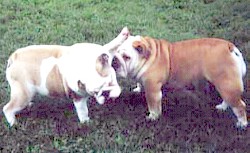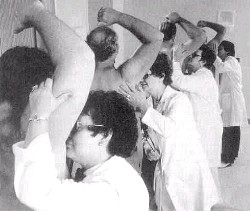|
We had a request for some information about what causes smelly underarm odours, so we sniffed around a little and came up with some information for this page, which we prepared just for you. (Not you? Of course not ... for the person next to you!) Armpit odour, or axillary malodor, usually begins when you reach puberty, when your glands start working. There are two kinds of sweat glands in the human body, the apocrine glands, which secrete a milky fluid from the hair follicles, and the eccrine glands, which are the source of most perspiration. The sweat from the eccrine glands is water, which is used to cool the body by evaporation and to moisten the friction surfaces of the body.  Most axillary, or armpit, sweat is odourless, and comes from the eccrine glands. The small amount of apocrine secretion in the sweat, however, causes the problem. Although fresh apocrine sweat is also odourless, it develops its characteristic smell when the sweat is broken down by the hair and skin cells in the armpit, and then eaten by bacteria. It's actually the bacteria that make the smell, releasing a chemical called 3-methyl-2-hexenoic acid .  About 90% of men and 70% of women have these bacteria in their armpit, and women produce a milder odour than men. Most people have trouble smelling their own odour without burying their nose in their own armpit ... probably because your brain filters out smells which are always present. About 90% of men and 70% of women have these bacteria in their armpit, and women produce a milder odour than men. Most people have trouble smelling their own odour without burying their nose in their own armpit ... probably because your brain filters out smells which are always present. Armpit odour is a problem for most adults, and usually gets worse with age. In some people, it can be so mild that deodorants aren't necessary, but in others, it can be so strong as to literally drive people away. Most people have some odour, especially after exercise, and prefer to do something about it. There has actually been very little study into what happens in your armpit .... most of the research, by the cosmetics industry, has been aimed at preventing the smell from being noticed. This is accomplished in two ways, through the application of either antiperspirants or deodorants. Antiperspirants act like a second skin under your armpit, preventing perspiration from being released. Without the sweat, the bacteria can't grow. Some people don't like the crusty feel that these leave on the skin. Deodorants are scents which mingle with the sweat, and try to disguise the smell being released by the bacteria. They usually work O.K., but only if you wash frequently, especially after exercise. They can't disguise really bad odours. Everything we do is designed to mask those odours. Deodorants and perfume, air sprays and central air conditioning, all do their part to help to hide how we smell.  People spend a lot of money trying to get rid of their body odours. This is unusual, because many other animals happily use their odours for communication and socialization. Theoretically, one function of armpit odour is to help us attract a mate. People spend a lot of money trying to get rid of their body odours. This is unusual, because many other animals happily use their odours for communication and socialization. Theoretically, one function of armpit odour is to help us attract a mate. However, there is no good evidence that human body odours, containing pheremones, can send signals between people, especially between men and women, other than the signal 'I stink'. We seem to have lost the ability to recognize these signals, despite what perfume makers claim. Incidentally, one reason why women's armpit odour is less offensive is probably because of the practice of shaving the armpit region. This is only a relatively recent practice; before about a hundred years ago, most Western women left the hair under their arms and on their legs, and still do in some cultures today. That a woman should have a bare armpit and shaven legs was an idea introduced by advertisers, who wanted to sell more razors; they linked the idea of a bare armpit and smooth legs with beauty, youth, and innocence, and their campaign worked ... most women accepted this new idea that body hair on women was 'unsightly', and still accept it today, at least in Western culture. Our idea of what is beautiful is still mainly decided by advertisers, so you don't see any hairy models. It would cost the cosmetics industry billions of dollars if women decided to stop shaving. However, the notion that hairiness in women is unsightly is so prevalent that most women accept the concept. Less than 1% (of American) women allow their underarm and leg hair to go permanently unshaven. (This statistic comes from the cosmetics industry, and may not be accurate, especially considering the growing numbers of people from other cultures who now live in North America)  Body odour is not a problem for most people. Just by practicing simple hygiene, such as taking regular baths or showers, reducing armpit hair, using an anti-odour deodorant or anti-perspirant, and changing your clothes often, you can stay relatively unstinky most of the time. Body odour is not a problem for most people. Just by practicing simple hygiene, such as taking regular baths or showers, reducing armpit hair, using an anti-odour deodorant or anti-perspirant, and changing your clothes often, you can stay relatively unstinky most of the time. Just remember that anything that causes you to sweat more, like physical activity or a hot day, will produce more apocrine secretion, and give bacteria more to eat; they'll quickly release more odour, and you will smell. More washing and deodorant will be needed.  The cosmetics industry goes to great lengths to ensure that you smell good. The effectiveness of both deodorants and antiperspirants is still tested in the old fashioned way, by the human nose. The cosmetics industry goes to great lengths to ensure that you smell good. The effectiveness of both deodorants and antiperspirants is still tested in the old fashioned way, by the human nose.Volunteer 'sniffers' smell the pits of up to 60 subjects an hour, taking three sniffs per pit, and rating offensive odours on a scale of 1 to 10. There might be the start of a good science fair experiment here ... O.K., maybe not. |